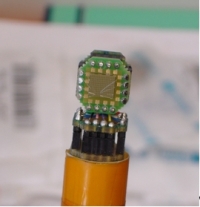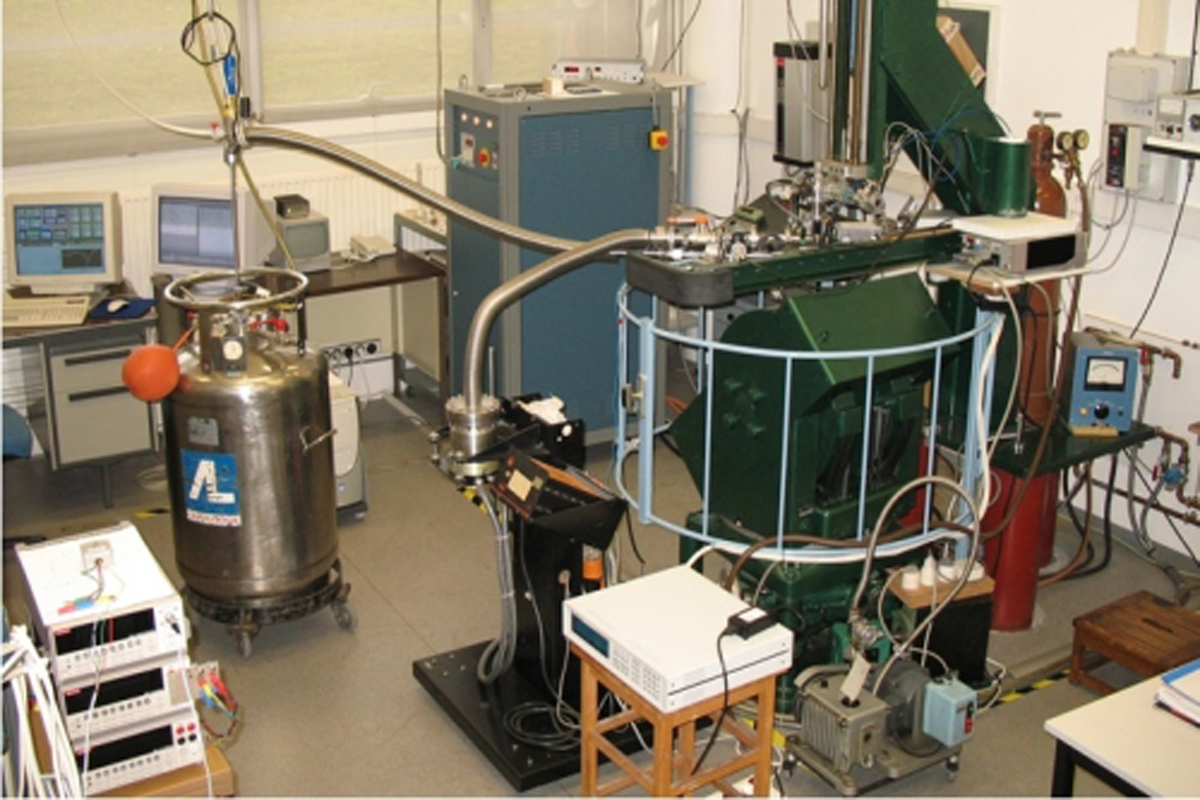The laboratory is equipped to perform various types of magneto-transport measurements, using standard 2-wire, 4-wire, or 6-wire (guarded) techniques. The device under test (DUT) can be submitted to DC, AC (with low-moderate frequencies), or DC+AC, voltage or current excitations. Hall effect, Anisotropic Magneto-Resistance (AMR), Giant Magneto-Resistance (GMR) in both Current-In-Plane (CIP) and Current-Perpendicular-to-Plane (CPP) geometries, Tunnel Magneto-Resistance (TMR), and Spin-Transfert experiments can be carried out.
The sample is usually mounted on a home-designed chip carrier offering a maximum of 16 electrical contacts to the external measurement circuit. The DUT is electrically connected to the carrier contact pads using aluminium wires attached with an ultrasonic wedge bonder (Hybond Model 572, clean room facility). The carrier is plugged at the bottom end of a vertical holder and positioned in the gap of an electromagnet. The latter is mounted on a rotating base and produces an horizontal magnetic field. The chip carrier may be set either horizontally or vertically.
Experiments can be carried out in a continuous flow He cryostat, at temperatures between 400 K and 4.5 K (1.6 K in single shot mode), with good temperature stability.
All instruments are computer controlled and data collection is automated using CEC TestPoint programs. I(V) characteristics, resistance and dynamic resistance (dV/dI) versus magnetic field or DC current are measured routinely. The Van der Pauw method of determining the specific resistivity and Hall coefficient of thin films can be implemented easily using a custom-built switching system.
A rudimentary manual four-probe station is also available for preliminary DC characterization, at room temperature and zero field.

CPP-GMR devices mounted on a customized chip carrier
Source/measurement equipments:
- Keithley Model 2400 sourcemeters
- Keithley Model 2002 digital multimeter + Model 1801 nanovolt preamp and 2000-SCAN 10 channel scanner card options
- Keithley Model 2182 nanovoltmeter
- Lakeshore Model 370 AC resistance bridge with Model 3716L low resistance 16 channel scanner
- Lakeshore Model 450 gaussmeter
- Signal Recovery Model 7265 DSP lock-in amplifier
Magnet:
Varian Model V3400 electromagnet with fixed 45° yoke and 9” flat poles (maximum field of 1.2 T in 2” gap), mounted on a motorized Model V3421 rotating base + Bruker Model BLMPS 45/180 C4 power supply with Model 2365B polarity inversion unit.
Cryogenics:
Oxford Instruments Model CF1200D continuous flow top loading cryostat, with ITC 503 temperature controller and automated needle valve LLT650 transfert tube.
These equipments are currently dedicated to the following research activities:
- AMR studies of the exchange-bias in hard/soft ferrimagnetic bilayers with antiferromagnetic interface coupling (in collaboration with Laboratoire de Physique des Matériaux, Nancy, France)
See e.g., Positive exchange-bias induced by interface domain wall quenching in GdFe/TbFe films,
Y. Henry, S. Mangin, T. Hauet, and F. Montaigne, Phys. Rev. B 73, 134420 (2006) - CPP-GMR and Spin transfert effects in nanopillars with reference and free layers magnetized perpendicular to the plane (in collaboration with Laboratoire de Physique des Matériaux, Nancy, Institut d’Electronique Fondamentale, Orsay, France, and Hitachi GST, San Jose Research Center, USA)
See e.g., Current induced domain wall states in CPP nanopillars with perpendicular anisotropy
D. Ravelosona, S. Mangin, Y. Henry, Y. Lemaho, J. Katine, B. Terris, and Eric E. Fullerton, J. Phys. D: Appl. Phys. 40, 1253 (2007) - Spin filtering effects in single crystal Fe/Cr/MgO/Fe(001) TMR junctions (in collaboration with Laboratoire de Physique des Matériaux, Nancy, France)

